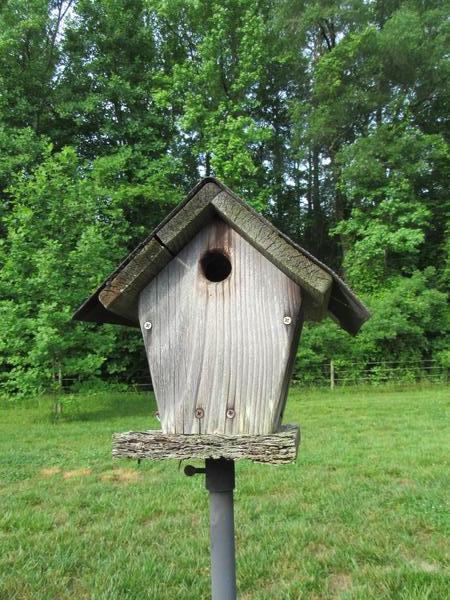Why Build Songbird Boxes?
North Carolina is home to a wide variety of songbirds, each with its own specific nesting requirements. Some of these songbird species nest only in cavities, such as abandoned woodpecker holes or natural cavities in live trees. Building songbird boxes is a simple, inexpensive way to create artificial cavities and attract these cavity-nesting songbirds to your property.
Properly constructed nest boxes can provide nesting options in areas with limited opportunities for cavity-nesting species. Boxes can be installed near your home, in orchards, pastures, parks, and fields, and even near your school or business.
Before You Begin
To be successful, you must first choose the species of bird you want to attract and understand its food, water, and cover requirements. Use the table below to determine the proper dimensions of the nest box for the species you want to attract. By choosing the correct dimensions and entrance hole sizes, you can furnish cool, dry, durable, easily-cleaned boxes for any of the small to medium-sized bird species in the table (Figure 1).
Materials for Songbird Boxes
To build:
- Tape measure
- Hammer
- 11⁄2 to 13⁄4-inch galvanized nails
- Pencil or chalk for marking
- Saw
- Lumber
To install:
- Stepladder or extension ladder
- 3-inch galvanized nails, lag bolts, or crimped wire
- Sheet metal for predator guard
Helpful Construction Hints
- Boxes need at least four 1⁄4-inch holes in the bottom to allow water to drain. An alternative to drilling drainage holes is cutting corners of the floor board to create drainage holes. Several 1⁄4-inch holes in the sides will provide adequate ventilation (Figure 2).
- A sloped roof that overhangs the front and sides of box can help keep out rain and discourage certain predators.
- Use durable, untreated woods such as cedar, pine, or cypress.
- Allow for the width of the sawblade when marking and cutting a board.
- When using hardwood lumber, drill starter holes for the nails to avoid splitting boards.
- Use coarse sandpaper to roughen smooth interior walls. This helps nestlings leave the nest when it is time to fledge.
- Avoid painting boxes or treating wood with a preservative. These boxes may absorb too much heat or give off toxic vapors.
- Do not install a perch on the box. Cavity-nesting birds do not need it and it can allow predators and competitors like house sparrows easier access.
- Hinge the roof or use a pivot nail on one side of the box to make periodic clean-up easier.
- Install a baffle or predator guard to help deter potential predators (figure 3).
|
Proper songbird box dimensions for various species. |
||||
|
Species |
Floor of Box (inches) |
Depth of Box (inches) |
Hole Size (inches) |
Hole Above Floor (inches) |
|
Eastern bluebird |
5.5 x 5.5 |
9 |
11⁄2 |
8 |
|
Chickadee |
5.5 x 5.5 |
8 |
11⁄8 |
6 |
|
Carolina wren |
4.5 x 5 |
6 – 8 |
11⁄2 |
4 - 6 |
|
Great crested flycatcher |
5.5 x 8 |
9 |
13⁄4 |
6 - 8 |
|
Songbird box placement. |
||
|
Species |
Box Height (feet) |
Placement |
|
Carolina wren Titmouse |
5 – 10 |
Forest edge; suburbs |
|
Eastern bluebird |
4 – 6 |
Fields, pastures, lawns |
|
Great crested flycatcher |
8 – 20 |
Forest and forest edge |
|
Prothonotary |
4 – 12 |
Forested wetland; over/facing water |
Installation and Maintenance
- Install all boxes by February. Many birds begin the nesting process early in the season.
- Place the boxes 200 to 300 feet apart to account for the territorial nature of most species.
- Firmly attach boxes to posts. Boxes attached to live trees are less likely to be used because of easy access to predators.
- Clean out all boxes each year after the young have fledged.
- Inspect boxes regularly.
- Always work in teams when using folding or extension ladders!
Working with Wildlife
North Carolina State University Extension - Forestry
Working With Wildlife Series
Publication date: May 24, 2019
Reviewed/Revised: May 28, 2024
N.C. Cooperative Extension prohibits discrimination and harassment regardless of age, color, disability, family and marital status, gender identity, national origin, political beliefs, race, religion, sex (including pregnancy), sexual orientation and veteran status.
N.C. Cooperative Extension prohibits discrimination and harassment regardless of age, color, disability, family and marital status, gender identity, national origin, political beliefs, race, religion, sex (including pregnancy), sexual orientation and veteran status.








